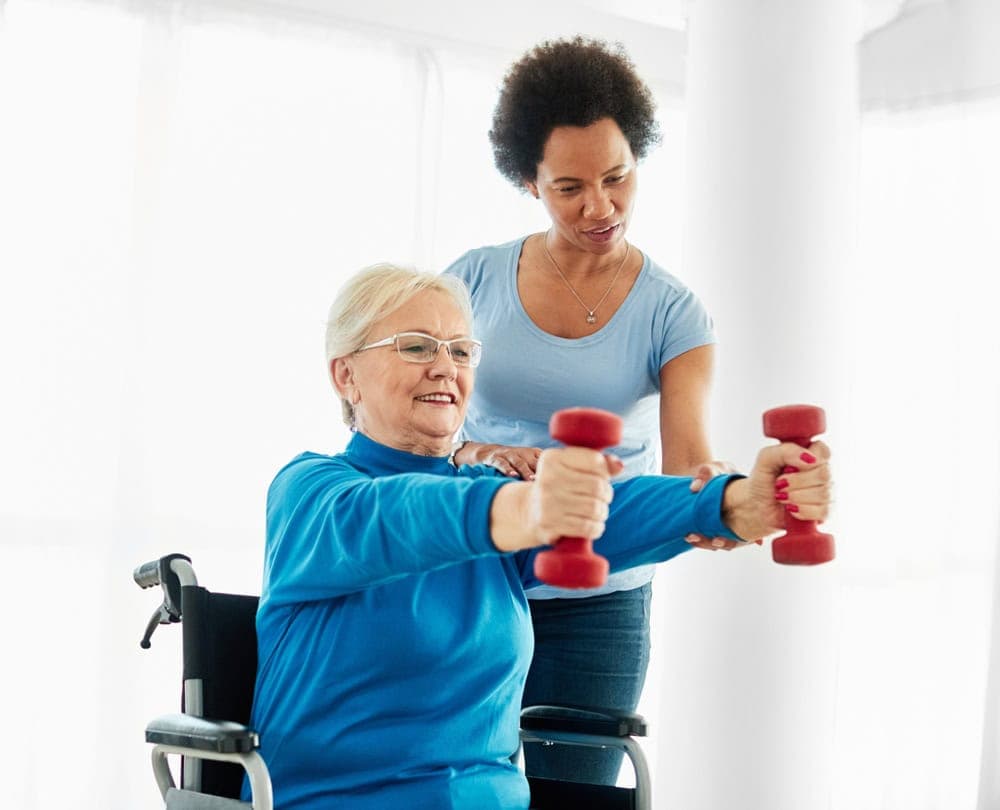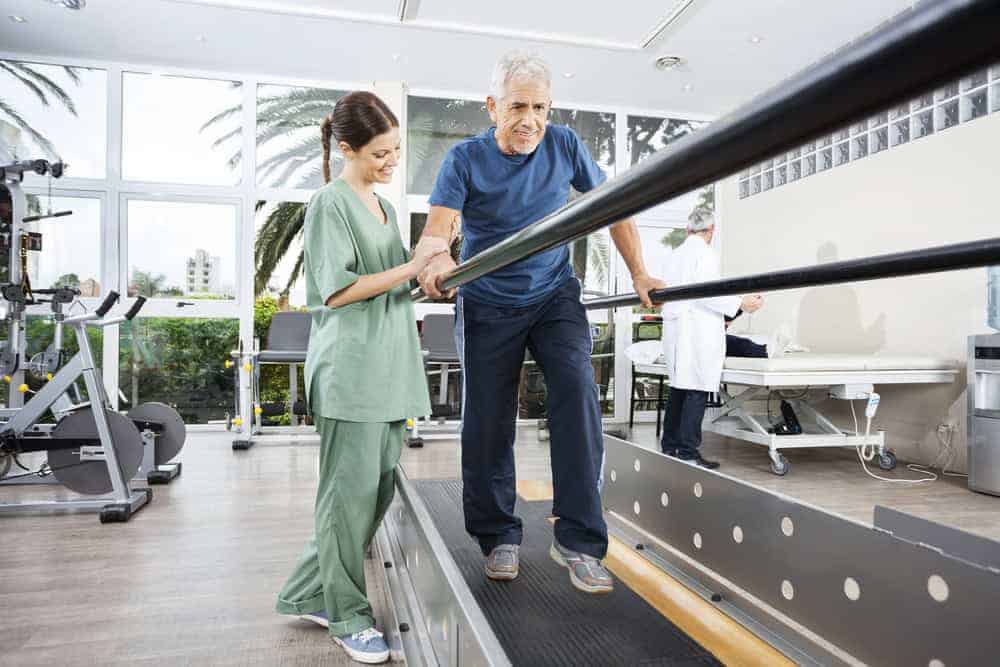
Do you find it harder to move around like you used to? Is chronic pain affecting your daily activities and overall quality of life? Do you wish there was a way to alleviate the pain and improve mobility and overall quality of life? Many seniors face mobility challenges as they age. Fortunately, physical therapy can help.
Contrary to popular belief, physical therapy isn’t just for athletes or those recovering from surgery. The intervention can help enhance mobility, reduce pain, and boost your general well-being. An effective therapy program can help seniors walk without feeling pain in their joints or climb stairs without assistance from others. Finding a good physical therapy clinic is the key to these upsides.
It can tailor a program specifically for you, addressing your unique needs, preferences, and goals. This individualized care can make a big difference in helping you stay active and independent. Explore how physical therapy can regain self-sufficiency, including how to choose the right physical therapy clinic to support your care needs.
Why Is Physical Therapy Important for Seniors

As we age, it becomes increasingly important to maintain our physical health. For seniors, physical therapy offers numerous benefits beyond just recovery from injuries or surgeries.
It’s a specialized healthcare service focused on enhancing movement, mitigating pain, and boosting quality of life.
With it, you can access the tools you need to stay active and independent for as long as possible. You can enjoy your golden years with freedom from mobility restrictions.
The Role of Physical Therapy for Seniors
One of the primary goals of physical therapy is to free older people from mobility restrictions. These concerns are subjective and unique for each person. For you or your elderly loved one, it may be walking without feeling like your joints could break with every move. Meanwhile, others just want to use the stairs without assistance.
Enhanced mobility leads to greater independence, which is crucial for seniors’ well-being. By engaging in regular physical therapy, you can continue to enjoy activities you thought were no longer possible, from gardening to dancing and playing with your grandchildren.
How Physical Therapy Addresses Mobility Limitations
Chronic pain is a common issue among older adults, often due to conditions like arthritis, osteoporosis, or past injuries. The National Institutes of Health revealed that 65% of people over the age of 65 are suffering from pain and up to 30% are chronic. In such cases, physical therapy can be a game-changer.
Through targeted exercises and techniques, physical therapists help manage and alleviate pain. It not only improves comfort but also reduces the need for pain medications, which can have unwanted side effects. A good physical therapy clinic will work with you to develop a pain management plan that addresses your specific needs.
How to Choose the Right Physical Therapy Clinic
Not sure which physical therapy clinic is right for you? With so many factors to consider, selecting the right facility and services is far from being a walk in the park.
Make sure the clinic meets your needs and offers the best possible care. Here are some key features to keep in mind:
1. Specialization in senior care
Look for clinics that cater specifically to the needs of older people. Therapists must have experience with common age-related conditions like osteoporosis, arthritis, and balance disorders. A focus on senior care will equip them with better skills to address older adults’ health challenges and provide the appropriate treatments.
2. Licensed and qualified therapists
Verify that physical therapists are licensed and have the necessary qualifications and credentials. The Federation of State Boards of Physical Therapy has an online direction to quickly look up whether someone is licensed and is what they claim to be.
Moreover, prioritize therapists with additional certifications in geriatric physical therapy, as this indicates specialized training in the needs of older adults. A qualified mobility expert will ensure safe treatment tailored to your needs.
3. Comprehensive services
Another thing to account for is the range of services a physical therapy clinic provides. The treatment program is rarely about one type of treatment — a combination of manual therapy, exercise programs, and aquatic therapy could be what will promote recovery.
It’s beneficial if the clinic provides comprehensive services, including specialized interventions for Parkinson’s disease or post-stroke rehabilitation. It’s way more convenient to receive all the care you need in one place, enhancing therapy experience and outcomes.
4. Accessibility and convenience
The location of the clinic is also important — it should be accessible to reduce travel stress. Consider options offering flexible hours and appointment scheduling to fit therapy sessions into your routine. Convenient access ensures you can attend your sessions regularly, which is crucial for progress.
5. Reputation and reviews
The internet has been a treasure trove of information for consumers when buying something. Look for online reviews and testimonials from other seniors who have used the clinic’s services. These details can provide insight into the quality of care and patient satisfaction.
Additionally, ask for recommendations from your primary care physician or friends who may have had positive experiences with local clinics.
6. Facility and equipment
Visit the physical therapy clinic to ensure it’s clean, well-maintained, and equipped with modern tools. Advanced equipment can aid in the treatment and provide better outcomes. A neat facility reflects the clinic’s commitment to high standards of care.
7. Personalized care plans
Ensure the clinic offers individualized treatment to meet your specific goals, preferences, and needs. Ask about the process for creating and adjusting these plans as your demands can increase or decrease during the treatment period.
An individualized care approach is essential for effective therapy as it addresses your unique health conditions and objectives.
8. Insurance and payment options
Confirm if the clinic accepts your insurance and understands the coverage details. If you qualify, Medicare can cover a significant portion of outpatient physical therapy services. The good thing is there’s no limit to how much it pays in one calendar year, but you need to cover 20% of the Medicare-approved amount if you meet the Part B deductible.
Inquire about payment plans or financial assistance if you have funding problems. Understanding your coverage can help sidestep unexpected expenses and ensure you receive the care you need without the added financial stress.
Tips and Resources to Access Quality Physical Therapy

Now that you know what to look for, here are some additional tips and resources to help you find a reliable physical therapy clinic.
Consult Your Primary Care Physician
Not sure where to start your search? Talk to your doctor. They often keep a list of reputable physical therapy clinics and give you insights into what type of therapy might be most beneficial for you. A referral from them ensures you start with a trusted and legitimate clinic.
Understand Your Insurance Coverage
Review your Medicare or private insurance plan to better understand what physical therapy services are covered. Contact your insurance provider for a list of in-network clinics. If you struggle with funding, they can help you decide where best to receive care without burning a hole in your pocket.
Utilize community resources
Senior centers and local health departments typically have information on recommended physical therapy clinics. Attend health fairs and community events to learn about your options. Community resources can be a great source of information and support as you navigate your therapy options.
Explore home-based therapy options
If you have mobility issues, you should know some clinics offer home-based therapy services. It can be extremely convenient since you don’t have to travel to and fro the location. Additionally, receiving care in a familiar environment can positively impact the treatment. Your family is also more likely to get involved when therapy is done at home.
Leverage telehealth services
Many clinics now offer telehealth options, enabling you to consult a therapist remotely. It’s useful if you live in a rural area or have difficulty traveling because of mobility challenges. Telehealth services can allow you access to expert advice and guidance without leaving your home.
Ask questions and advocate for yourself
Don’t hesitate to ask physical therapy clinics about their services, therapists’ qualifications, and treatment approaches. Be proactive in discussing your needs and ensuring you feel comfortable with the care you will receive. Advocacy is key to getting the best possible care.
Research online
Use online platforms to research and compare different clinics. Websites like Healthgrades publish reviews and ratings from other patients. Using health aggregator sites, you can search and filter legit physical therapy clinics and hear about their reputation from others, helping you make a better care decision.
By leveraging these resources, finding a physical therapy clinic that meets your needs and helps you achieve your health goals will be less taxing.
Why Individualized Treatment Program Is Critical

Certain health conditions require specialized care. For example, seniors with Parkinson’s disease benefit from therapy focused on balance and coordination. On the other hand, those recovering from a stroke may need intensive rehabilitation to regain lost functions.
No two seniors are the same, and their therapy treatment shouldn’t be either. Individualized treatment programs are crucial in addressing the unique needs of each person — these programs take into account your health history, current condition, and personal goals. A tailored approach ensures therapy is both effective and engaging, leading to better outcomes and increased satisfaction.
Physical therapy clinics customizing their interventions are better equipped to address seniors’ needs. Ask about the availability of these services when choosing a clinic.
Advancements in Therapy Techniques and Equipment
Implementing modern innovations is also a crucial aspect of individualized care. Thanks to advancements in techniques and equipment, physical therapy has come a long way throughout the years. Now, modern clinics use state-of-the-art tools and methods to enhance the therapy experience.
For example, robotic-assisted therapy can help improve gait and balance to support someone following a stroke attack. Meanwhile, virtual reality can make exercises more engaging. Staying updated on these advancements can help seniors and their families choose a clinic that offers the most effective and innovative care.
How to Maximize the Benefits of Physical Therapy
For seniors in assisted living facilities, integrating physical therapy into their daily routine can make a big difference. Many have on-site physical therapists or partners with local clinics, making it easier for residents to receive quality, consistent care
Regular therapy sessions can help maintain mobility, prevent falls, and enhance overall well-being. If you’re planning to relocate to a long-term care unit, it’s worth discussing these options with the facility manager. Here is how you can maximize the benefits of physical therapy.
Join Consistent Therapy Sessions
Consistency is key in physical therapy. Regular sessions help reinforce progress and keep seniors on track with their goals. These sessions often include functional training, which focuses on improving everyday activities like walking, dressing, and bathing.
Over time, seniors who participate in regular therapy see significant improvements in their ability to perform these tasks independently, which ultimately boosts their confidence and quality of life.
Communicate With the Care Team
A collaborative approach to care is essential in assisted living settings. Physical therapists should work closely with other healthcare providers, including doctors, nurses, and occupational therapists, to create a comprehensive care plan. Seniors must do the same to allow seamless treatment.
This team approach guarantees that all aspects of a senior’s health are addressed, from physical mobility to mental well-being. Regular communication between seniors, their families and providers can help address any issues promptly, leading to better overall outcomes.
Overcome Care Barriers
Navigating the healthcare system to access physical therapy can be challenging for many seniors. Numerous obstacles, such as mobility issues, financial constraints, and limited availability of specialized therapists, can hinder anyone from receiving the care they need.
Physical therapy clinics must understand these challenges and explore solutions to break down these barriers.
Seniors must do the same since there’s a limit to how much physical therapists can do about these challenges. For instance, you can arrange your transportation through friends and families if what hinders you from receiving care is a reason you can control. There should be effort on both sides to overcome the care obstacles.
How to Address Challenges in Obtaining Physical Therapy Services

Some circumstances hinder seniors from receiving care. Here are some of the common challenges and ways to address them:
1. Mobility issues
Due to physical limitations, many seniors have difficulty traveling to their physical therapy appointments. To address this, look for clinics that offer transportation services or home-based therapy options. This way, you can receive care without the need for travel.
2. Lack of transportation
Transportation can be a significant barrier for those who no longer drive. Explore community transportation services, senior shuttles, or rideshare options specifically designed for you. Some insurance plans may also cover transportation to medical appointments, so make sure to check with your provider.
3. Financial constraints
The cost of physical therapy can be a concern, especially for older people without any means of income. To mitigate this, check your insurance coverage to understand what physical therapy services can you financially outsource to your provider. Moreover, some physical therapy clinics offer sliding scale fees or payment plans. Community programs may provide financial assistance for seniors needing therapy.
4. Limited availability of specialized therapists
Not all areas have therapists who specialize in senior care or specific conditions. Researching larger clinics or hospitals that have a broader range of specialists can help. Also, telehealth services can connect you with specialized therapists who are not locally available.
5. Awareness and education
Seniors and their families may not be fully aware of the benefits of physical therapy or how to access it. Educate yourself through reliable sources. Ask your primary care physician and don’t hesitate to ask questions. Visit senior centers. Check trusted online platforms. Attending community health fairs and workshops can also provide valuable information.
6. Long wait times for appointments
High demand for services can lead to long wait times for initial appointments. To resolve this, schedule appointments as early as you can. Consider clinics with shorter waiting lists. Some facilities offer expedited scheduling for urgent cases.
7. Language and cultural barriers
Language differences and cultural misunderstandings can affect effective communication. Therefore, look for clinics with bilingual staff or translation services. It’s important to find a therapist who understands and respects your cultural background.
What Are Therapy Options for Seniors with Mobility Limitations

For seniors with significant accessibility issues, traditional physical therapy might not be possible. However, there are several alternative options to still receive care without the burden of traveling to a clinic. Here are some solutions to consider:
1. Home-based physical therapy
Therapists come to your home, bringing necessary equipment and providing care in a familiar environment. This option eliminates the need for travel and can be more comfortable for those with severe mobility issues. More importantly, it supports one-on-one personalized treatment.
2. Telehealth services
Virtual therapy sessions conducted via video calls allow you to remotely consult with a therapist. It reduces travel burdens. Plus, you can schedule it at your convenience, making it useful for those living in rural areas or with severe mobility limitations.
3. Community-based programs
Local senior centers, community health organizations, and non-profits usually provide physical therapy services or exercise programs. These options can be more affordable and accessible. They also offer opportunities for social interaction and community support.
4. Adaptive equipment and technology
Using specialized equipment, such as canes, walkers, and mobility aids, can help with exercises. Adaptive equipment helps you perform physical activities safely at home. Some technology solutions include apps guiding you through exercises and monitoring your progress.
5. In-home exercise programs
Your therapist can customize exercise routines you can do by yourself. They’ll teach you the appropriate forms or postures safely so you can increase your self-sufficiency. You can check in with them every week or more to check your progress.
6. Day rehabilitation programs
Some rehabilitation centers offer programs where you spend the day receiving therapy and return home in the evening. These options, which often include transportation services, provide intensive therapy while allowing you to maintain your home life.
7. Assisted living facilities with on-site therapy
Some facilities have on-site physical therapists and partners with local clinics. These services make it easier to integrate therapy into daily routines, ensuring consistent care.
Seniors with mobility limitations can receive physical therapy to improve their health and quality of life. The key is knowing their options. Discuss the alternatives with your healthcare provider to determine the best approach for your situation.
Advocating for Improved Access to Senior Physical Therapy
Advocacy plays a crucial role in boosting access to physical therapy services. Families and caregivers can work together to push for better policies and increased funding for senior healthcare. Joining local advocacy groups or participating in community health boards can amplify your voice. You can help create a better and more inclusive healthcare system.
Empowering Seniors Through Physical Therapy

Physical therapy can be a transformative part of your healthcare plan, offering numerous benefits that go beyond just physical mobility. By actively participating in treatment, you can help you achieve your health goals and enhance your overall quality of life.
Importance of Goal Setting and Patient-Focused Therapy
Here are factors contributing to successful therapy outcomes and why they’re crucial.
Personalized goals
Establishing personalized goals guarantees your therapy plan is tailored to your needs and preferences. Whether it’s walking a certain distance, reducing pain levels, or improving balance, having clear objectives makes therapy more meaningful and focused.
Motivation and accountability
Clear goals provide motivation and a sense of purpose. They give you something to strive for and boost your commitment to the therapy program. Meeting with your therapist to review and adjust goals keeps you accountable and engaged in the process.
Progress tracking
Goals allow you to track your progress over time. Seeing improvements, no matter how small, can elevate your confidence. It encourages you to continue with your treatment, too. You need to meet with your therapist for assessments to know what’s working and what might need to change.
Customized care plans
A patient-focused therapy plan takes into account your current condition, health history, and personal preferences. Therapists use these details to customize your exercises. Personalized interventions result in better adherence and outcomes.
Ongoing Communication
Setting goals inspires better communication between you and your therapist. It ensures everyone is on the same page regarding expectations and treatment direction. Open conversations can enhance the overall therapy experience.
How to Encourage Seniors to Prioritize Physical Therapy

Encouraging active participation in physical therapy is essential for achieving the best outcomes. Here are some strategies you can use to get involved with the treatment.
- Education and awareness: Understanding the benefits of physical therapy can motivate you to prioritize it. Learn how it can improve mobility, reduce pain, and enhance overall well-being.
- Support from family and caregivers: Family members and caregivers play a very important role in supporting your therapy journey. They can hold you accountable, remind you of appointments, and assist with exercises at home.
- Celebrate milestones: No matter how trivial they seem, celebrate your achievements! Reaching therapy milestones can boost your confidence and reinforce the positive impact of your efforts. Reward yourself. Acknowledge your progress to maintain enthusiasm and commitment.
- Create a routine: Do you find it hard to stay consistent with the treatment? The only way is to do it for continuity and momentum. Remember that every session you attend gets you closer to reclaiming your life. Overcome the resistance by focusing on your recovery. Consistency is key to seeing long-term benefits.
- Positive mindset: Maintaining a positive attitude towards therapy can significantly impact your outcomes. Focus on the improvements and benefits rather than the challenges to stay motivated.
- Community and social interaction: Engaging with others in the same situation can be a source of support and encouragement. Group therapy sessions or community exercise programs can make therapy more enjoyable. Moreover, they foster a sense of camaraderie.
By setting personalized goals and maintaining a patient-focused therapy plan, you can make significant strides in your overall well-being. In the end, the goal is to live an independent and fulfilling life.
Choose the Best Physical Therapy Clinic
Physical therapy is your pathway to a healthier and more active life. By choosing the right physical therapy clinic, you can significantly enhance your well-being. Whether you’re addressing chronic pain, recovering from an injury, or simply seeking to improve your mobility, it offers tailored solutions to meet your unique needs.
Amy’s Eden Senior Care partners with licensed physical therapists around Nevada. This network allows us to make care accessible. We arrange for rehabilitation services to be available for seniors living in our homes or any location they call home. Our caregivers work with therapists to help implement treatment plans for faster recovery.
Your path to a more independent life could be just a few therapy sessions away. Contact us today to reclaim your independent and active lifestyle with therapy.




